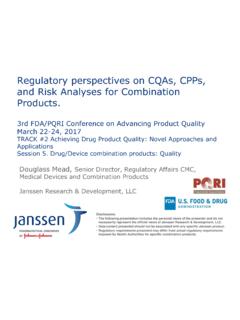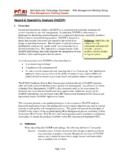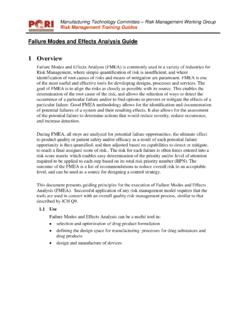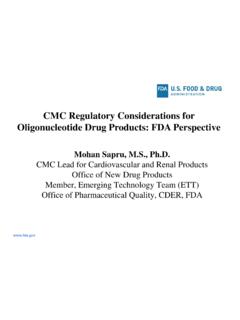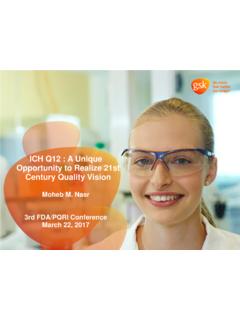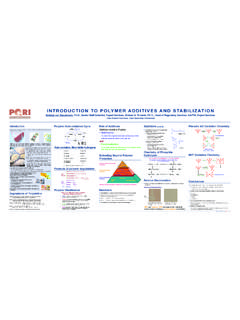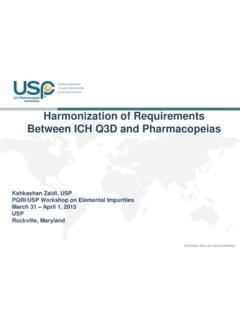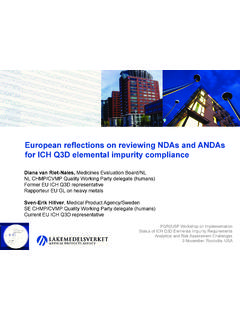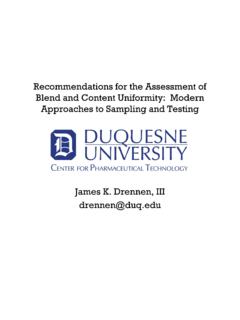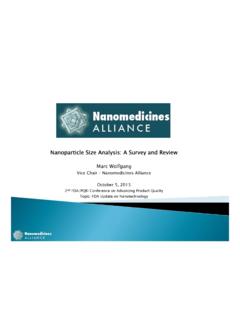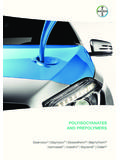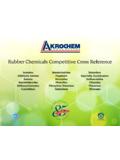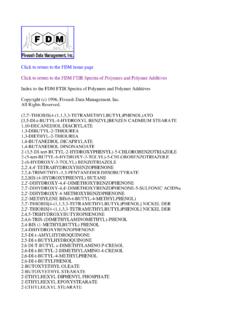Transcription of Thresholds and Best Practices for Extractable and …
1 Thresholds and Best Practices for Extractable and leachables PQRI-PODP Working Group Recommendations: Parental Drug Products (PDP) Ophthalmic Drug Products (ODP) 3rd PQRI/FDA Conference on Advancing Product Quality Washington DC, 22 March 2017 Overview of Thresholds and Best Practices for Extractable and leachables (L&E) 3rd PQRI/FDA Conference on Advancing Product Quality Washington DC, 22 March 2017 Diane Paskiet Chair of PQRI PODP L&E Working Group Director of Scientific Affairs, West Pharmaceutical Services Objectives PQRI L&E Mission and Scope Threshold Concept and Extraction Studies Safety and Quality Points to Consider 3rd PQRI/FDA Conference on Advancing Product Quality 3 Mission Statement The Product Quality Research Institute (PQRI) is a non-profit consortium of organizations working together to generate and share timely, relevant, and impactful information that advances drug product quality and development.
2 By virtue of its diverse membership, PQRI provides a unique forum to focus critical thinking, conduct research, exchange information, and propose methodology or guidance to pharmaceutical companies, regulators, and standard setting organizations. 3rd PQRI/FDA Conference on Advancing Product Quality 4 OINDP Safety Thresholds and Best Practices 3rd PQRI/FDA Conference on Advancing Product Quality 5 Safety Concern Threshold (SCT) Low Risk leachables Not Identified < g/day Qualification Threshold (QT) Assessment of Identified Leachable Non-carcinogenic >5 g/day Best Practices for E&L studies Controlled Extraction Studies (CES) Analytical Evaluation Threshold (AET) Identification threshold Note: Designed to reduce level of uncertainty within pharmaceutical development Not meant to be proscriptive Finding leachables 3rd PQRI/FDA Conference on Advancing Product Quality 6 Before Thresholds After Safety Thresholds The Forest Through the Trees Analytical Evaluation Threshold 3rd PQRI/FDA Conference on Advancing Product Quality 7 The AET is defined as the threshold at or above which an OINDP pharmaceutical development team should identify and quantify a particular Extractable and/or leachable and report it for potential toxicological assessment.
3 How low to go to Identify Potential leachables Linking Chemistry (AET) to Toxicology (SCT) =/canisteractuations120/dayactuations 8g/day Estimated AET Estimated3rd PQRI/FDA Conference on Advancing Product Quality 8 leachables and Extractables PODP Working Group PROPOSED WORK PLAN , March 2008 Development of Scientifically Justifiable Thresholds and Best Demonstrated Characterization Practices for leachables and Extractables in Parenterals and Ophthalmic Drug Products (PODP) Approved 2009 8 Threshold concepts and best demonstrated Practices developed for leachables in OINDP can be extrapolated to PODP with considerations of factors dose, duration, patient population, materials and product characteristics of PODP. Considered for: Prefilled Syringe (PFS), Small and Large Volume Parenterals (SVP)/(LVP), and Ophthalmic/Blow Fill Seal (BFS) Disposable systems should also be considered in the absence of defined and specific regulatory guidance Consistent with the principles of QbD and good science Safety Depends on Intended Use Dosage Form Route of Administration Material(s) of Construction Patient Population Dosing Duration Product Specific Attributes 3rd PQRI/FDA Conference on Advancing Product Quality 9 Extractables Identification Process Illustration of Extractable Testing 3rd PQRI/FDA Conference on Advancing Product Quality 10 Test Articles (Material Type) Format Composition (Supplier Information) Application Category Polycarbonate (PC)
4 Injection moulded plaques PHR Irganox 1076 PHR Irgafos 168 Ports, Tubes LVP Rubber Elastomer (Bromobutyl) Sheet Brominated isobutylene isoprene copolymer ( ) calcined aluminum silicate, titanium dioxide, ; paraffinic oil, ; zinc oxide, SRF Carbon block mixture, calcined magnesium oxide, 4,4 -dithiodi-morpholine/polyisobutylene, Closures, Plungers, Gaskets SVP Cyclic Olefin Copolymer (COC) Plaques Irganox 1010 Ultramarine Blue Syringes, Vials PFS, SVP Polyvinylchloride (PVC) Pellets PVC resin DEHP 30% Epoxidized oil 7% Zn stearate Ca stearate Stearamide 1% Bags, Tubing LVP Low density polyethylene (LDPE) Blown Film Irganox B 215 (2:1 blend of Irgafos 168 and Irganox 1010) 1000 ppm BHT 200 ppm Calcium Stearate 500 ppm Erucamide 500 ppm Chimassorb 944 2000 ppm Overpouch, BFS, Containers BFS, SVP, LVP Recommendations Document 3rd PQRI/FDA Conference on Advancing Product Quality 11 Thresholds Best Practices AET LVP, SVP, PFS Applications Considerations Given Ophthalmics Biologics Development of Parenteral Drug Product (PDP) Thresholds Database of 606 Extractable and Leachable compounds Use of in-silico methods Modified Cramer approach (ToxTree) Genotoxicants (DEREK & SARAH Irritants and sensitizers (DEREK plus literature confirmation).)
5 Note: Ophthalmic qualification will emphasize concentration (ppm) not dose ( g/day) for leachables in an ophthalmic DP 3rd PQRI/FDA Conference on Advancing Product Quality 12 PQRI Toxicology Team Approach 606 Compound Sort 3rd PQRI/FDA Conference on Advancing Product Quality 13 Cramer (ToxTree) Sort I (53%) II (8%) III (34%) IV (11%) I II III (83%) Class IV Cramer Classification Breakdown PQRI Qualification Process 3rd PQRI/FDA Conference on Advancing Product Quality 14 Routine Leachable Study Identify chemicals for safety assessment g 5 g 50 g Genotoxic Concern? Ye s Qualify (ICH M7) No Consider S/I Potential S/I Concern? Ye s Qualify No Consider Systemic Toxicity Systemic Toxicity Concern? Ye s Qualify No DP CCS is Qualified! Application of AET 3rd PQRI/FDA Conference on Advancing Product Quality 15 Experimental Key Characteristics Material Characterization (Tentative leachables ) Screening of packaging candidates Establish composition of Extractable materials Broad Based/Screening extraction and testing protocols Semi-quantitative character Toxicological Alerts Simulation Study (Potential leachables ) Establish worst case accumulation of leachables Conditions to mimic worst case exposure Justified simulating solvents Assessment of all extractables above the AET Identify Leachable Targets Migration Study (Confirmed leachables ) Establish the actual accumulation of target leachables Drug product under actual conditions of use Toxicological assessment of all targeted leachables Outcome.
6 Negligible or unacceptable safety risk Thresholds and Best Practices for Parenteral and Ophthalmic Drug Products (PODP) Workshop February 22-23, 2011 System Compatibility &Safety Materials & Components Glass, Plastics, Rubbers, SS Processing Impact Washing/Coatings/ Sterilization System Assembly Storage Conditions Time/Temperature Packaging Secondary Fill/Finish Ancillary Tertiary 3rd PQRI/FDA Conference on Advancing Product Quality 16 Material Understanding Biologics Safety and Quality Considerations Minor or nontoxic leachables and incompatible materials may induce changes to product quality attributes, stability, purity and/or efficacy Changes in product quality Biologics are often unstable and quality characteristics may not be completely defined Characterization includes: physicochemical properties, biological activity, immunochemical properties, purity Container Closure Systems Compatibility Leachable interaction with biologic or formulation Physical interaction with material surface or surface interfaces Functional performance of manufacturing, storage and delivery systems 3rd PQRI/FDA Conference on Advancing Product Quality 17 Risk to Protein Aggregation 3rd PQRI/FDA Conference on Advancing Product Quality 18 Reference: Characterization of Protein Aggregation & Adsorption on Prefillable Syringe Surfaces; Esfandiary et al.
7 University of Kansas; and Vinod Vilivalam, West Pharmaceutical Services, Inc.; 2008. Siliconized No Silicone Oil Silicone Oil Compatibility Issue Safety Concern Particulate formation of fusion protein 25 mg/mL; agitation conditions during simulated shipment Risk to Protein Adsorption 3rd PQRI/FDA Conference on Advancing Product Quality 19 Development of Analytical Techniques to Determine Protein Adsorption on Sterilized Parenteral Packaging Containers and Stoppers; Lloyd Waxman et. Al. AAPS Poster, 2015 Freeze Thaw Cycle Mechanical Stress 3rd PQRI/FDA Conference on Advancing Product Quality 20 Adapted from G. Jiang , Novel Mechanisms of Glass Delamination in Type1A Borosilicate Vials Containing Frozen Protein Formulations PDA J Pharm Sci and Tech 2013 Risk @ -70C for Particles/Lamella, leachables , Cracks/Breakage *Placebo samples and control showed 2-5 ppb leachable Al Antibody Lamella ppb Si ppb B ppb Al* Control 0 11,954 1,085 53 A (-30C) 0 11,589 1,140 43 B (-30C) 0 11,949 1,334 52 C (-70)C 13 11,686 1,123 35 D (-70C) 30 12,124 1,302 31 E (-70C) 17 11,082 939 29 F (-70C) 5 11,531 1,068 31 Process-relevant Stress Conditions/Actual Contact Surface Exposure PODP Points to Consider A Safety Concern Threshold (SCT)
8 Of g/day for an AET A Classification Strategy was developed o qualify identified leachables and extractables in PDP Special Safety considerations apply for extractables and leachables in Ophthalmic Drug Products (ODP) Special Quality considerations apply to biologics and system compatibility 3rd PQRI/FDA Conference on Advancing Product Quality 21 PODP Points to Consider Extractable studies should be considered for materials of construction, finished components, complete packaging systems to inform on: Tentative Leachable (Characterization) Extraction solvents with consideration of extraction pH, organic solvent content, and other appropriate extraction conditions Potential leachables (Simulation) Situations of analytically challenging AETs for certain PODPs Assessment of multiple components in final packing systems Simulation studies can establish an extractables profile representing the worst-case leachables profile.
9 3rd PQRI/FDA Conference on Advancing Product Quality 22 PODP Chemistry Sub-Team 3rd PQRI/FDA Conference on Advancing Product Quality 23 Diane Paskiet, Director of Scientific Affairs, West Pharmaceutical Services PODP Chair Dennis Jenke, , Chief Executive Scientist, Triad Scientific Solutions, LLC Chemistry Chair Jim Castner, , Pharma Interface Analysis, LLC. Thomas Egert, Boehringer Ingelheim Pharma GmbH & Co. KG Thomas Feinberg, , President, SCIO Analytical, LLC Alan Hendricker, , Principal Specialist, Becton Dickinson Christopher Houston, , Director, iuvo BioScience Desmond G. Hunt, , Senior Scientific Liason, USP Michael Lynch, , Executive Director, Keryx Biopharmaceuticals Ingrid Markovic, , Division of Therapeutic Proteins, FDA Kumudini Nicholas, Team Leader, Pharmaceutical Quality Review, Bureau of Pharmaceutical Sciences, Health Canada Daniel Norwood, , Executive Partner, SCIO Analytical, LLC Mike Ruberto, , Material Needs Consulting, LLC Art Shaw, , Associate Research Fellow, Pfizer (Retired) Edward J.
10 Smith, , Packaging Science Resources, LLC All research work supported under the direction of PQRI PODP Toxicology Sub-Team Douglas J. Ball, MS, DABT, Research Fellow, Pfizer Toxicology Chair Stephen A. Barat, , Executive Director, Allergan Steve Beck, CEMDD Liaison, GlaxoSmithKline William P. Beierschmitt, , Associate Research Fellow, Pfizer David Jones, Principal Scientific Officer, New Chemical Entities Unit, MHRA Abigail Jacobs, , Associate Director for Pharmacology/Toxicology, CDER, FDA Jacqueline A. Kunzler, , Vice President Quality Compliance, Baxter Healthcare Mary Richardson, , DABT, Chief Scientific Officer, iuvo BioScience Tim Robinson, Division of Pulmonary and Allergy Products, CDER, FDA Alisa Vespa, , Assessment Officer, Metabolism and Musculoskeletal Drugs Division, Bureau of Metabolism, Oncology and Reproductive Sciences, Therapeutic Products Directorate, Health Canada 3rd PQRI/FDA Conference on Advancing Product Quality 24 PODP Extended Team Laboratory Services Baxter Roopang Shah, Research Associate II Marek Ciesla, Research Associate II Frank (Yousheng) Hua, Research Scientist Catalent Pharma Solutions Paul Cvetich Kimberly Davis
